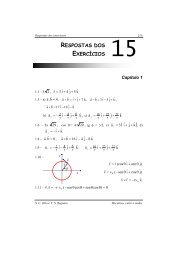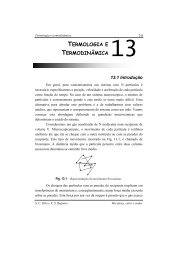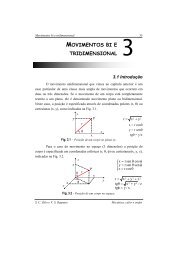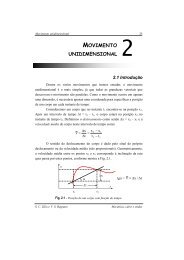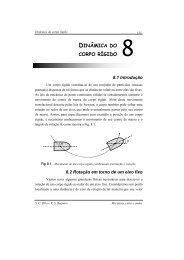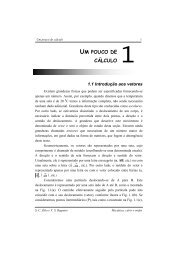Nonlinear Optics - Fotonica.ifsc.usp.br - USP
Nonlinear Optics - Fotonica.ifsc.usp.br - USP
Nonlinear Optics - Fotonica.ifsc.usp.br - USP
Create successful ePaper yourself
Turn your PDF publications into a flip-book with our unique Google optimized e-Paper software.
Introduction to <strong>Nonlinear</strong> <strong>Optics</strong><<strong>br</strong> />
fs-laser microfa<strong>br</strong>ication<<strong>br</strong> />
Prof. Dr. Cleber R. Mendonca
Sao Carlos<<strong>br</strong> />
University of Sao Paulo - Brazil<<strong>br</strong> />
students 77.000<<strong>br</strong> />
52.000 undergrad.<<strong>br</strong> />
25.000 grad.<<strong>br</strong> />
employers 15.000<<strong>br</strong> />
professors 6.000<<strong>br</strong> />
• Sao Paulo<<strong>br</strong> />
• Sao Carlos (9.000)<<strong>br</strong> />
• Ribeirao Preto
University of Sao Paulo – in Sao Carlos
Picosecond laser<<strong>br</strong> />
Laser Nd:YAG<<strong>br</strong> />
Qswitched/modelocked<<strong>br</strong> />
532nm and 1064 nm<<strong>br</strong> />
100 ps<<strong>br</strong> />
150-fs laser system<<strong>br</strong> />
Amplifier Ti:safira<<strong>br</strong> />
775 nm<<strong>br</strong> />
150 fs<<strong>br</strong> />
800 μJ
30-fs amplified laser system
microfa<strong>br</strong>ication lab
Part 1: Introduction to <strong>Nonlinear</strong> <strong>Optics</strong><<strong>br</strong> />
Prof. Dr. Cleber R. Mendonca
Linear optics<<strong>br</strong> />
Outline<<strong>br</strong> />
Part 1: Introduction to nonlinear optics<<strong>br</strong> />
Introduction to nonlinear optics<<strong>br</strong> />
Second order nonlinearities<<strong>br</strong> />
Third order nonlinearities<<strong>br</strong> />
Two-photon absorption<<strong>br</strong> />
Part 2: fs-laser microfa<strong>br</strong>ication<<strong>br</strong> />
Applications of nonlinear optics in<<strong>br</strong> />
laser microfa<strong>br</strong>ication
Linear optics vs <strong>Nonlinear</strong> optics<<strong>br</strong> />
<strong>Optics</strong> is a <strong>br</strong>anch of physics that describes the behavior and properties of light<<strong>br</strong> />
and the interaction of light with matter. Explains optical phenomena.<<strong>br</strong> />
<strong>Nonlinear</strong> <strong>Optics</strong><<strong>br</strong> />
The <strong>br</strong>anch of optics that describes optical phenomena that occur when very<<strong>br</strong> />
intense light is used
Linear optics<<strong>br</strong> />
Maxwell equations<<strong>br</strong> />
ρ: charge density<<strong>br</strong> />
J: current density<<strong>br</strong> />
P: electric polarization<<strong>br</strong> />
M: magnetization
Linear optics<<strong>br</strong> />
P e M: response of the media to the applied field<<strong>br</strong> />
Electric Polarization<<strong>br</strong> />
p
Linear optics<<strong>br</strong> />
Maxwell equations can be combined, leading to an equation<<strong>br</strong> />
describing the electromagnetism<<strong>br</strong> />
Constitutive relationships<<strong>br</strong> />
r r<<strong>br</strong> />
P = χE<<strong>br</strong> />
r r<<strong>br</strong> />
M = χ H m<<strong>br</strong> />
r r<<strong>br</strong> />
J = σE<<strong>br</strong> />
response of the media<<strong>br</strong> />
to the applied field
Linear optics<<strong>br</strong> />
wave equation ( = 0 ; J = 0 )<<strong>br</strong> />
r<<strong>br</strong> />
ρ<<strong>br</strong> />
left<<strong>br</strong> />
Light propagation in vacuum<<strong>br</strong> />
right<<strong>br</strong> />
Matter-light interaction
harmonic oscillator<<strong>br</strong> />
Linear optics<<strong>br</strong> />
electron on a spring<<strong>br</strong> />
k<<strong>br</strong> />
E rad.
electron on a spring<<strong>br</strong> />
equation of motion<<strong>br</strong> />
Linear optics
Linear optics<<strong>br</strong> />
harmonic oscillator<<strong>br</strong> />
Steady state: electron oscillates at driving frequency
Oscillating dipole<<strong>br</strong> />
Polarization oscillator<<strong>br</strong> />
P(<<strong>br</strong> />
t)<<strong>br</strong> />
Linear optics<<strong>br</strong> />
Ne m<<strong>br</strong> />
= E<<strong>br</strong> />
2<<strong>br</strong> />
ω − iωγ<<strong>br</strong> />
( 2<<strong>br</strong> />
−ω<<strong>br</strong> />
)<<strong>br</strong> />
0<<strong>br</strong> />
2 /<<strong>br</strong> />
0<<strong>br</strong> />
P = χE<<strong>br</strong> />
linear response
y comparison<<strong>br</strong> />
then<<strong>br</strong> />
Linear optics<<strong>br</strong> />
~ Ne<<strong>br</strong> />
χ = 2<<strong>br</strong> />
m<<strong>br</strong> />
( 2<<strong>br</strong> />
ω −ω<<strong>br</strong> />
) − iωγ<<strong>br</strong> />
0<<strong>br</strong> />
2 /<<strong>br</strong> />
0<<strong>br</strong> />
which is a complex number<<strong>br</strong> />
where and are the real and imaginary parts of the complex index of refraction<<strong>br</strong> />
refraction absorption
Linear optics
absorption<<strong>br</strong> />
Linear optical process<<strong>br</strong> />
refraction<<strong>br</strong> />
α 0 does not depend on light intensity n 0 does not depend on light intensity<<strong>br</strong> />
absorption of 10 % index of refraction 1.3
<strong>Nonlinear</strong> optics<<strong>br</strong> />
high light intensity<<strong>br</strong> />
E rad. ~ E inter.<<strong>br</strong> />
How high should be the light intensity ?
Inter-atomic electric field<<strong>br</strong> />
e = 1.6 × 10 -19 C<<strong>br</strong> />
r ~ 4 Å<<strong>br</strong> />
E ~ 1 × 10 10 V/m<<strong>br</strong> />
<strong>Nonlinear</strong> optics<<strong>br</strong> />
cw laser<<strong>br</strong> />
P = 20 W<<strong>br</strong> />
w o = 20 μm<<strong>br</strong> />
I<<strong>br</strong> />
2P<<strong>br</strong> />
=<<strong>br</strong> />
πw<<strong>br</strong> />
I = 3 × 10 10 W/m 2<<strong>br</strong> />
E o = 4 × 10 6 V/m<<strong>br</strong> />
2<<strong>br</strong> />
0
Inter-atomic electric field<<strong>br</strong> />
E ~ 1 × 10 10 V/m<<strong>br</strong> />
<strong>Nonlinear</strong> optics<<strong>br</strong> />
pulsed laser<<strong>br</strong> />
I = 10 GW/cm 2 =<<strong>br</strong> />
10 × 10 13 W/m 2<<strong>br</strong> />
E o = 1 × 10 8 V/m
<strong>Nonlinear</strong> optics<<strong>br</strong> />
anharmonic oscillator<<strong>br</strong> />
anharmonic term<<strong>br</strong> />
high light intensity<<strong>br</strong> />
E rad. ~ E inter.
P<<strong>br</strong> />
=<<strong>br</strong> />
potential energy<<strong>br</strong> />
χ<<strong>br</strong> />
anharmonic oscillator<<strong>br</strong> />
E<<strong>br</strong> />
charge displacement<<strong>br</strong> />
nonlinear polarization response<<strong>br</strong> />
( 1 )<<strong>br</strong> />
+<<strong>br</strong> />
χ<<strong>br</strong> />
( 2 )<<strong>br</strong> />
E<<strong>br</strong> />
<strong>Nonlinear</strong> optics<<strong>br</strong> />
2<<strong>br</strong> />
+<<strong>br</strong> />
χ<<strong>br</strong> />
( 3 )<<strong>br</strong> />
E<<strong>br</strong> />
3<<strong>br</strong> />
+<<strong>br</strong> />
...<<strong>br</strong> />
P<<strong>br</strong> />
E
anharmonic oscillator<<strong>br</strong> />
P<<strong>br</strong> />
=<<strong>br</strong> />
χ<<strong>br</strong> />
( 1 )<<strong>br</strong> />
<strong>Nonlinear</strong> optics<<strong>br</strong> />
nonlinear polarization response<<strong>br</strong> />
E<<strong>br</strong> />
+<<strong>br</strong> />
χ<<strong>br</strong> />
( 2 )<<strong>br</strong> />
E<<strong>br</strong> />
2<<strong>br</strong> />
+<<strong>br</strong> />
high light intensity<<strong>br</strong> />
E rad. ~E inter.<<strong>br</strong> />
χ<<strong>br</strong> />
( 3 )<<strong>br</strong> />
E<<strong>br</strong> />
3<<strong>br</strong> />
+ ...
wave equation ( = 0 ; J = 0 )<<strong>br</strong> />
r<<strong>br</strong> />
ρ<<strong>br</strong> />
left<<strong>br</strong> />
Light propagation in vacuum<<strong>br</strong> />
<strong>Nonlinear</strong> optics<<strong>br</strong> />
right<<strong>br</strong> />
Matter-light interaction
P = χ<<strong>br</strong> />
nonlinear expansion of the polarization<<strong>br</strong> />
( 1)<<strong>br</strong> />
r<<strong>br</strong> />
. E + χ<<strong>br</strong> />
linear<<strong>br</strong> />
processes<<strong>br</strong> />
<strong>Nonlinear</strong> optics<<strong>br</strong> />
( 2 )<<strong>br</strong> />
r r<<strong>br</strong> />
(<<strong>br</strong> />
: EE<<strong>br</strong> />
+ χ<<strong>br</strong> />
3 )<<strong>br</strong> />
r r r<<strong>br</strong> />
MEEE<<strong>br</strong> />
+ ...<<strong>br</strong> />
SHG THG<<strong>br</strong> />
Kerr effect
<strong>Nonlinear</strong> optics<<strong>br</strong> />
nonlinear expansion of the polarization
χ<<strong>br</strong> />
( 2)<<strong>br</strong> />
Second order processes<<strong>br</strong> />
ω 1<<strong>br</strong> />
ω 2<<strong>br</strong> />
<strong>Nonlinear</strong> <strong>Optics</strong><<strong>br</strong> />
χ (2)<<strong>br</strong> />
–If ω 1 = ω 2<<strong>br</strong> />
– second harmonic generation: 2 ω<<strong>br</strong> />
– optical retification: 0<<strong>br</strong> />
ω 1 +ω 2<<strong>br</strong> />
ω 1 −ω 2
( 2 )<<strong>br</strong> />
χ<<strong>br</strong> />
Second Harmonic Generation<<strong>br</strong> />
Phase Matching<<strong>br</strong> />
( ω) v(<<strong>br</strong> />
2ω)<<strong>br</strong> />
v =
Second order processes<<strong>br</strong> />
Second Harmonic Generation<<strong>br</strong> />
ω 2ω<<strong>br</strong> />
<strong>Nonlinear</strong> <strong>Optics</strong><<strong>br</strong> />
( 2<<strong>br</strong> />
χ<<strong>br</strong> />
λ = 1064nm λ = 532nm<<strong>br</strong> />
)
( 2<<strong>br</strong> />
χ<<strong>br</strong> />
)<<strong>br</strong> />
Second Harmonic Generation<<strong>br</strong> />
1- higher energy light<<strong>br</strong> />
2- transparent material
<strong>Nonlinear</strong> <strong>Optics</strong><<strong>br</strong> />
in medium with inversion symmetry<<strong>br</strong> />
and consequently
Third order processes<<strong>br</strong> />
ω 1<<strong>br</strong> />
ω 2<<strong>br</strong> />
ω 3<<strong>br</strong> />
<strong>Nonlinear</strong> <strong>Optics</strong><<strong>br</strong> />
)<<strong>br</strong> />
3<<strong>br</strong> />
(<<strong>br</strong> />
χ<<strong>br</strong> />
χ (3)<<strong>br</strong> />
–If ω 1 = ω 2 = ω 3<<strong>br</strong> />
– Third harmonic generation: 3 ω<<strong>br</strong> />
– Self phase modulation: ω<<strong>br</strong> />
ω 1 +ω 2 +ω 3<<strong>br</strong> />
ω 1 −ω 2 −ω 3<<strong>br</strong> />
ω 1 −ω 2 +ω 3
(<<strong>br</strong> />
χ<<strong>br</strong> />
2 )<<strong>br</strong> />
=<<strong>br</strong> />
0<<strong>br</strong> />
<strong>Nonlinear</strong> polarization<<strong>br</strong> />
Third order polarization<<strong>br</strong> />
<strong>Nonlinear</strong> <strong>Optics</strong><<strong>br</strong> />
χ<<strong>br</strong> />
( 3)<<strong>br</strong> />
Third order processes
consequently<<strong>br</strong> />
and<<strong>br</strong> />
<strong>Nonlinear</strong> <strong>Optics</strong><<strong>br</strong> />
Kerr media<<strong>br</strong> />
n n0<<strong>br</strong> />
n2I<<strong>br</strong> />
+ =
χ (3) is a complex quantity<<strong>br</strong> />
<strong>Nonlinear</strong> <strong>Optics</strong>
Third order processes: χ (3)<<strong>br</strong> />
Refractive process:<<strong>br</strong> />
n n0<<strong>br</strong> />
n2I<<strong>br</strong> />
+ =<<strong>br</strong> />
• self-phase modulation<<strong>br</strong> />
• lens-like effect<<strong>br</strong> />
Absorptive process:<<strong>br</strong> />
α = α + β 0 I<<strong>br</strong> />
• nonlinear absorption<<strong>br</strong> />
• two-photon absorption
Two-photon absorption (2PA) process<<strong>br</strong> />
Phenomenon does not described for the Classical Physics and does not<<strong>br</strong> />
observed until the development of the Laser.<<strong>br</strong> />
1-photon absorption<<strong>br</strong> />
(Linear)<<strong>br</strong> />
2-photon absorption<<strong>br</strong> />
(<strong>Nonlinear</strong>)<<strong>br</strong> />
Theoretical model: Maria Göppert-Mayer, 1931<<strong>br</strong> />
Two photons from an intense laser light beam are simultaneously absorbed<<strong>br</strong> />
in the same “quantum act”, leading the molecule to some excited state with<<strong>br</strong> />
energy equivalent to the absorbed two photons.
2ω<<strong>br</strong> />
two-photon absorption<<strong>br</strong> />
ω<<strong>br</strong> />
ω<<strong>br</strong> />
Applications:<<strong>br</strong> />
Abs<<strong>br</strong> />
optical limiting<<strong>br</strong> />
fluorescence microscopy<<strong>br</strong> />
microfa<strong>br</strong>ication<<strong>br</strong> />
α = α0<<strong>br</strong> />
+ βI<<strong>br</strong> />
λ
2PA<<strong>br</strong> />
localization of the excitation with 2PA<<strong>br</strong> />
dilute solution of fluorescent dye<<strong>br</strong> />
1PA<<strong>br</strong> />
spatial confinement of excitation
excitation profile along z<<strong>br</strong> />
Radius, area and intensity of focused beam<<strong>br</strong> />
I(<<strong>br</strong> />
one photon<<strong>br</strong> />
two photon<<strong>br</strong> />
⎛ z<<strong>br</strong> />
ω(<<strong>br</strong> />
z ) = ω0<<strong>br</strong> />
⎜<<strong>br</strong> />
⎜1+<<strong>br</strong> />
⎝ z<<strong>br</strong> />
2 2<<strong>br</strong> />
A( z ) = πω = πω0<<strong>br</strong> />
z ) =<<strong>br</strong> />
E<<strong>br</strong> />
At<<strong>br</strong> />
1<<strong>br</strong> />
∝ =<<strong>br</strong> />
A<<strong>br</strong> />
0<<strong>br</strong> />
⎞<<strong>br</strong> />
⎟<<strong>br</strong> />
⎠<<strong>br</strong> />
1 ⎟<<strong>br</strong> />
0<<strong>br</strong> />
⎟<<strong>br</strong> />
⎛ z ⎞<<strong>br</strong> />
⎜ +<<strong>br</strong> />
⎝ z ⎠<<strong>br</strong> />
1<<strong>br</strong> />
2<<strong>br</strong> />
0 1<<strong>br</strong> />
⎛<<strong>br</strong> />
πω ⎜ +<<strong>br</strong> />
⎝<<strong>br</strong> />
z<<strong>br</strong> />
z<<strong>br</strong> />
Normalized excitation rates<<strong>br</strong> />
(ignoring beam attenuation)<<strong>br</strong> />
I(<<strong>br</strong> />
I(<<strong>br</strong> />
I(<<strong>br</strong> />
I(<<strong>br</strong> />
z ) ⎛<<strong>br</strong> />
= 1<<strong>br</strong> />
0 ⎜ +<<strong>br</strong> />
) ⎝<<strong>br</strong> />
z ) ⎛<<strong>br</strong> />
= 1<<strong>br</strong> />
0 ⎜ +<<strong>br</strong> />
) ⎝<<strong>br</strong> />
z<<strong>br</strong> />
z<<strong>br</strong> />
0<<strong>br</strong> />
z<<strong>br</strong> />
z<<strong>br</strong> />
0<<strong>br</strong> />
⎞<<strong>br</strong> />
⎟<<strong>br</strong> />
⎠<<strong>br</strong> />
−2<<strong>br</strong> />
⎞<<strong>br</strong> />
⎟<<strong>br</strong> />
⎠<<strong>br</strong> />
0<<strong>br</strong> />
−4<<strong>br</strong> />
⎞<<strong>br</strong> />
⎟<<strong>br</strong> />
⎠<<strong>br</strong> />
2<<strong>br</strong> />
2
This is the end of Part 1<<strong>br</strong> />
for a copy of this presentation<<strong>br</strong> />
www.fotonica.<strong>ifsc</strong>.<strong>usp</strong>.<strong>br</strong><<strong>br</strong> />
presentation



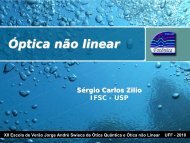
![Curso-Escola-JAS1.ppt [Modo de Compatibilidade] - Fotonica.ifsc ...](https://img.yumpu.com/21076978/1/190x135/curso-escola-jas1ppt-modo-de-compatibilidade-fotonicaifsc-.jpg?quality=85)
